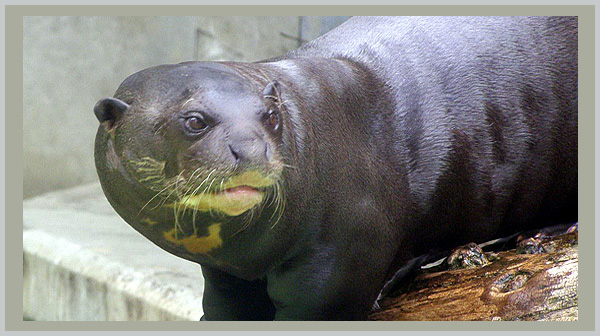
Giant Otter
Name: Giant Otter (Pteronura brasiliensis)
Conservation Status: Endangered (2021 IUCN Red List)
Wild Population Estimate: 2,000 – 5,000
Range: South America
Threats: Mining / Hunting and Trapping / Pollution / Shipping Lanes / Invasive Species
The giant otter is the South American cousin to the sea and river otters of North America, as well as those of Europe and Africa. The giant otter can grow to more than 6 feet (2 meters) long and 70 pounds (32 kg), nearly twice as large as its American counterparts.
Giant otters once were found throughout the Tropical rainforests of the Amazon, down to Brazil’s Pantanal, the world’s largest wetland. Today they are found only in the most remote waters in tropical South America. Hunting for their luxuriant fur, along with habitat loss, has reduced their numbers to an estimated 2,000 to 5,000.
Giant otters live in lakes and slow-moving rivers in forested areas. They are perfectly adapted to their watery environment, with large, webbed feet and stout tails to guide them through submerged vegetation, and ears and noses that close when they dive in search of prey. An adult otter may consume up to ten pounds (4.5 kg) of fish a day.
Giant otters are very social animals. They live in extended families of perhaps ten otters. They hunt cooperatively and share babysitting duties. The groups respect territories and do not fight with each other. Each group’s stable social structure is centered on the life-bonded dominant pair, which is the only pair that reproduces. The group raises one to four cubs annually.
Causes of Endangerment
Overexploitation
Giant otters have no predators except humans, who once hunted them widely for their fur. Their fur is among the finest in the world, so dense that water never reaches their skin. Hunting otters was profitable and easy. A single giant otter pelt was worth more than a year’s annual wage for a local resident.
Otters are very inquisitive, and groups approaching canoes to get a better look were easy targets. The fur trade nearly eliminated them by 1970; between 1950 and 1970, Peru alone exported 20,000 otter pelts.
In 1973, giant otters were listed on Appendix I of CITES, which means all trade in their pelts was prohibited. Prohibiting trade in pelts eliminated the biggest threat to the otter’s survival. But giant otters are still shot by settlers who do not know the law and fishers who regard them as competitors.
Habitat Loss and Pollution
Currently, the biggest threat to giant otters is habitat loss from human settlement and pollution. Protecting otters requires protection of their prey, and the fish stocks of the Pantanal are pressured by habitat destruction, overfishing, and pollution. Mining is one significant source of pollution.
Gold miners use mercury to separate ore from mud, using 2 to 3 grams of mercury to extract 1 gram of gold. They heat the gold and mercury compound to burn off the mercury. The mercury is released into the air during burning and it falls on the land and is washed into the water system as rain.
All fish-eating predators, including otters, crocodiles, and humans, are threatened by mercury poisoning.
Another threat comes from simple human activities such as the use of motorboats or motorized canoes. Otters are very sensitive to disturbance and will abandon their range with the advent of human settlement. Most human settlement in South America is concentrated along waterways, so otters have been seriously affected by human encroachment.
Tourism
Increased tourism is another potential problem for otters. Tourism is both a blessing and a threat. It brings money and attention to help conservation of otters. At the same time, unwitting tourists in motor boats can come too close to denning otters.
If tourists are not careful, the stress of people invading their range can cause mother otters to stop producing milk and the cubs can starve to death.
Conservation Actions
Trade Regulation
Trade in giant otter fur was prohibited under CITES in 1973. Conservationists believe this step had a tremendous effect on the giant otter survival, and their numbers may be increasing.
Protected Areas
The remaining remote and pristine rivers, lakes, and wetlands of South America house a large variety of threatened and endangered species. These include spotted cats, marsh deer, giant anteaters, and other rare creatures.
Questions for Thought
Why do you think most human settlement in South America is concentrated along waterways?
How does the fact that only one pair per group reproduces, affect recovery of otter populations?
Can tourism be compatible with protection of otter habitat? What kinds of guidelines or facilities for tourists would help?
What do you think should be done about threats to the otter’s food supply, especially overfishing and pollution?
Explore:
Related Classroom Activities:
[CS1-1,CS1-3,CS2-4, General]
Click here for Endangered Species Classroom Glossary